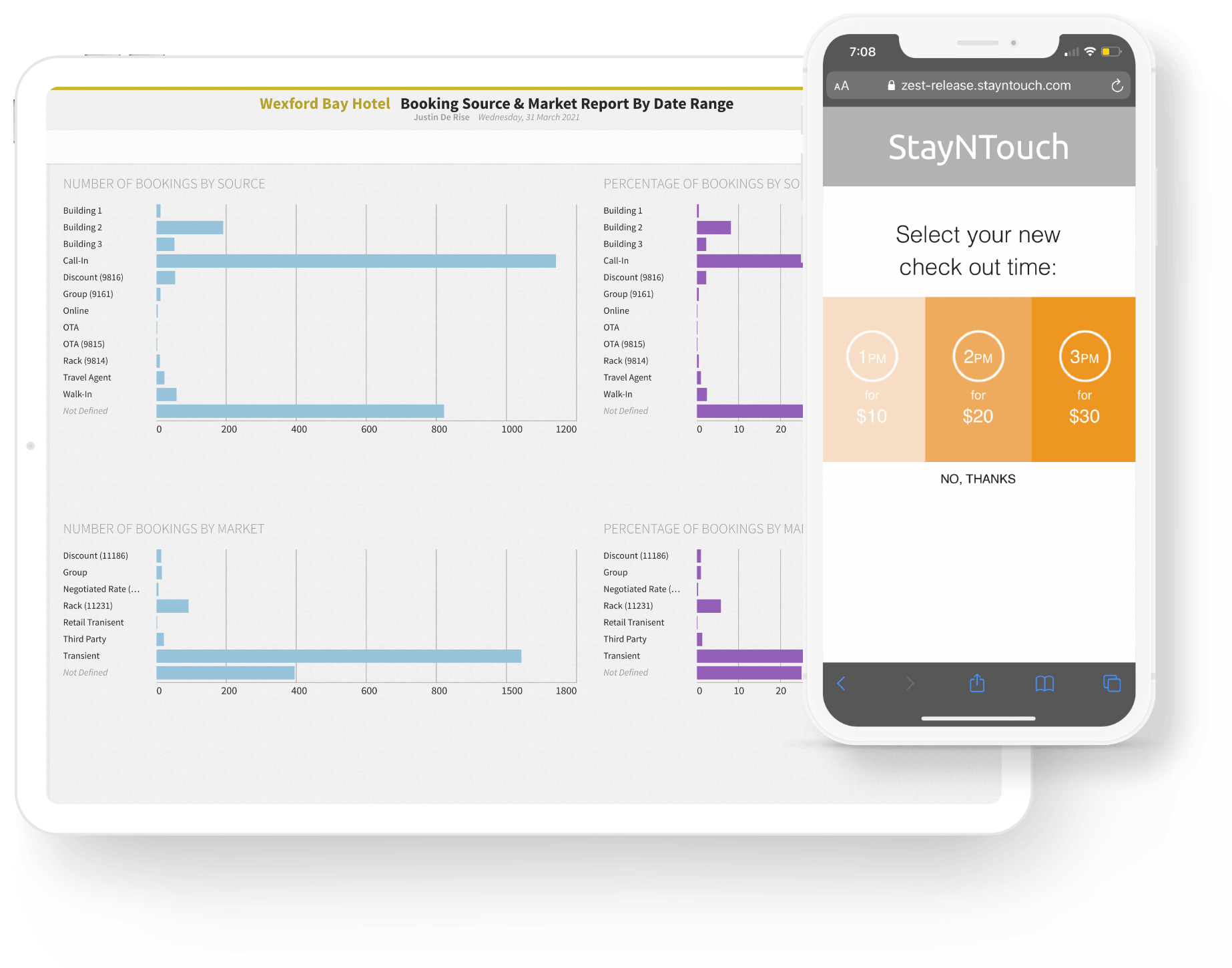
Hotel Housekeeping App: So Long Clipboards, Hello Technology
Hotel’s can gain a great operational advantage from implementing mobile housekeeping app solutions. —Justin DeRise We have spent most of our time on this blog
Think about a hypothetical stay at a tech-forward hotel: A guest starts to research a relaxing beach getaway, and after settling on a destination and accommodations, they book a hotel from their home desktop computer through a common OTA. When their plane lands, they decide to check-in on the Uber ride to their hotel and use their smartphone to check into their room, pay their deposit, and receive the codes for their keyless entry. Once inside their room, the guest uses the hotel’s mobile SMS messaging service to instantly order room service, book activities for the weekend, and make requests without having to physically interact with staff. When the trip is over, the guest is so impressed with their experience, that they sign up for the hotel’s loyalty program, and plan to book directly on the hotel’s website for future stays.
This is the type of seamless, hyper-personalized guest experience that innovative hotels and hotel brands across the globe are trying to construct. But several barriers continue to stand in the way of this personalized scenario, from poorly integrated platforms, to the reluctance of guests to provide personal data, to legacy technology that hinders the delivery of organic hospitality. In this article, we explore three ways that mobile technology can remove barriers to personalization, thus paving the way for a seamless and customizable guest journey.
What do you notice about the hypothetical guest journey presented in the introduction? The guest interacts with the hotel through a myriad of digital and physical touchpoints, utilizing several different personal devices (desktop, mobile phone, tablet, etc) and hotel platforms (IBE, PMS, guest messaging system, digital payments, keyless entry, etc). If all is working properly, the customer will experience a seamless guest journey from platform-to-platform and touchpoint-to-touchpoint. This unified journey not only makes for a convenient and pleasant trip, it also lays the foundation for a guest profile that personalizes the entire guest experience. Once a guest is recognized by a hotel’s technological ecosystem, it is better able to deliver the guests’ ideal room and rate combinations, amenity preferences, and custom requests.
Conversely, siloed platforms and disjointed tech stacks make enhanced personalization almost impossible. There’s an old adage in the hospitality industry: “If you have to ask a longtime customer ‘have you stayed with us before,’ you have just reset your relationship back to zero.” The same applies to the digital space. If a hotel’s ecosystem cannot identify a guest from touchpoint-to-touchpoint and from device-to-device, it won’t be able to develop the comprehensive guest profile necessary to properly anticipate the guest’s preferences and tailor the hotel’s messaging and offerings.
Choosing a PMS with an open-API architecture lays the necessary conditions for seamless integrations, but hotels have to go further to build a truly unified and personalized guest journey. Ideally, PMS platforms should be built on a native-cloud foundation like Amazon’s AWS, which offers unparalleled speed and reliability, and can automatically scale its performance upwards with increased usage. Powerful and simplified webhooks are another necessary enhancement. Unlike traditional APIs, which only function when a request comes from outside applications, webhooks automatically send data when initiated by a triggering event. The result is like having a thread leading directly to the proverbial needle in the haystack, allowing the platforms to have the exact data that they need, exactly when they need it.
Modern travelers want a personalized in-stay experience, but they are also rightly worried about privacy and data security. This makes it difficult for hotels to collect foundational guest data through traditional means. While guests will readily provide identifying information to OTAs in exchange for lower rates, they will often wonder why the front desk agent checking them in needs their phone number or email. Adopting an ironclad data security policy that complies with international PCI and GDPR standards is a necessary first step, but it doesn’t address the underlying issue because it doesn’t provide a benefit to guests for relinquishing their identifying data.
But this is exactly where mobile or kiosk-based self check-in can be so effective. By integrating a PMS with mobile check-in functionality with a digital payment gateway, a keyless entry system, and a guest messaging platform, a hotel provides guests with a way to bypass the front desk and check into their room in under a minute through their smartphone. This option empowers guests to craft their own ideal welcome experience, giving them a solid incentive to provide their email and phone number, thus laying the groundwork to personalize their stay even further.
And the benefits don’t end when the guest enters their room. Mobile check-in can also be leveraged to send targeted automated messages for room upgrades, amenities, and monetized early check-in/late checkout, directly to the guest’s smartphone, while mobile guest messaging allows the guest to instantly connect with staff through their favorite mobile messaging platform. Integrating with a CRM or an online reputation manager can extend personalization into the post-stay through the inclusion of customizable loyalty programs and post-stay surveys.
While personalization has made incredible strides in the digital realm, nothing can replace the positive effect that a warm, proactive, and empathetic hotelier can have on a guest’s stay. Unfortunately, legacy technology places all sorts of barriers between hoteliers and their guests: From stiff and scripted check-in dialogues, to clunky and complicated software menus, to the physical barrier of the front desk itself. Ultimately, the goal of technology should be to unburden the process of providing hospitality, so that a more organic type of hospitality can occur spontaneously.
Getting rid of the front desk is a good first step. A mobile PMS allows hoteliers to manage their property from a tablet, giving them the freedom to roam their entire hotel and meet guests wherever they are on property. Instant mobile communication and action managers allow any staff member to instantly handle any guest request, so no hotelier will ever have to say, “I’m sorry, that isn’t my department.” A colorful and intuitive user interface, combined with robust automation can also enable hotel staff to process requests while keeping their focus on their guests 一 and not buried in their screens. Of course, maintaining comprehensive guest profiles is a critical part of facilitating personalized hospitality, giving the staff member easy access to vital information about the guest’s reservation, stay history, preferences, and special requests, and allowing them to engage in more natural conversations about how they could have a more meaningful impact on the guest’s stay.
Actualizing the hyper-personalized guest journey is on the horizon 一 as long as hotels can identify and overcome the common barriers to personalization. Building a truly personalized guest experience requires seamless platform and data integration, guest buy-in through tangible enhancements to their stay, and technology that empowers hoteliers to deliver warm and organic hospitality.

Hotel’s can gain a great operational advantage from implementing mobile housekeeping app solutions. —Justin DeRise We have spent most of our time on this blog

“Hotels around the world are using technology in new ways, with the goal of speeding up or personalizing more services for guests. Personalization continues to

Once the province of the big hotel chains, property management systems (PMS) have recently become more affordable. They are now helping a new generation of


See how StayNtouch’s Cloud PMS, Guest Mobility, and Guest Kiosk solutions deliver better results for hotels through better front & back of house communication, increased mobile touch-points, more revenue and operational efficiency, and unlimited interfaces.
Your demo will include how to:

Manage and Set Tasks Across Your Departments

Ensure Guest Satisfaction & Safety With Contactless Check-in Options

Automate Easy Upsells & Monetized Early/Late Checkouts

Set & Manage Rates/Availability

Integrate With Tools and Platforms Essential
to Your Hotel
And More!